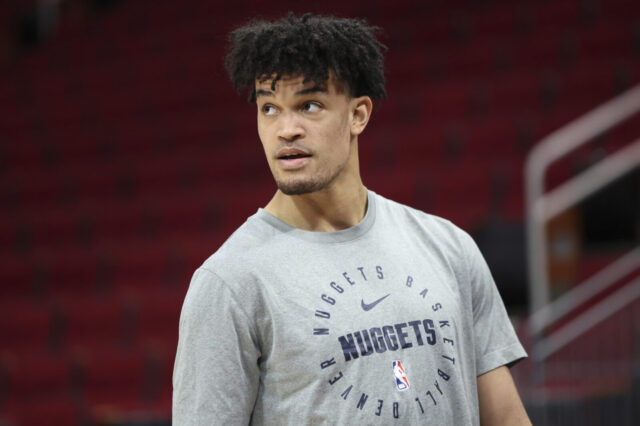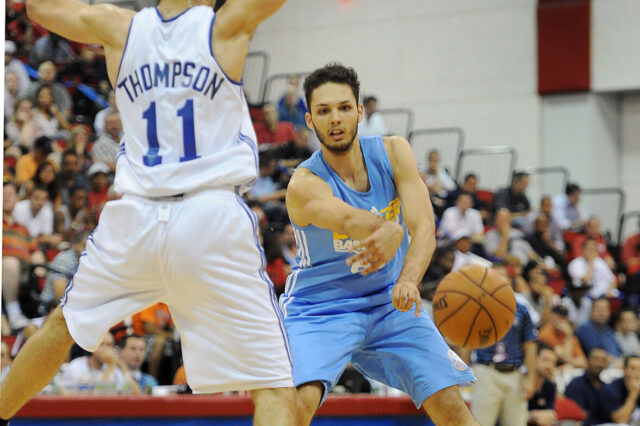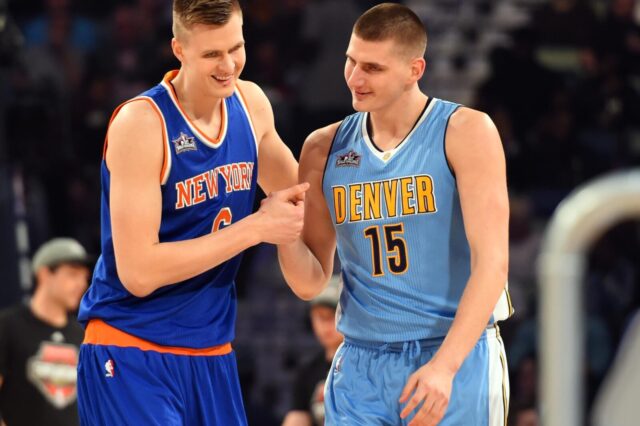It’s been another disappointing year for Emmanuel Mudiay. The second-year point guard didn’t show much of an improvement in his sophomore season with the Denver Nuggets, especially in the areas where he needed the most work. By December 14th, Mudiay was averaging the 12th most turnovers in the NBA and shooting the 10th worst field-goal percentage among players to play at least 20 minutes per game. By the end of January, Mudiay was cut from the starting lineup and removed from the rotation. He played just 50 minutes between the time he received his first DNP-CD on February 6th and the final five games of the season when he was forced back into the rotation thanks to an injury to Jameer Nelson.
Mudiay wasn’t the only young Nuggets prospect to struggle and ultimately get cut from the Nuggets rotation this season. Jusuf Nurkic, who showed flashes of brilliance in his two and a half seasons in Denver, also struggled over the first few months of this season. Like Mudiay, Nurkic was simultaneously taken out of the starting lineup and cut from the rotation after a disappointing start to the season.
There is evidence that Mudiay and Nurkic were a bad fit together and that both played a role in each other’s demise. Mudiay played a total of 1407 minutes this season. Over one third of those minutes came with Nurkic on the court beside him. In those 501 minutes, the Nuggets held a horrendous -19.1 net rating thanks in large part to an absurdly low, 96.5 offensive rating.* In the 906 minutes that Mudiay played with Nurkic on the bench, the Nuggets had a +3 net rating and a very healthy 117.7 offensive rating.
This content is no longer available.
The stark contrast between those two numbers is enough to at least ask the question: is Mudiay really that bad? Or was he just a really bad fit with certain lineups?
Mudiay and Nurkic have very mismatched skill sets. Mudiay’s best skill is getting past the first line of defense and into the painted area, using his size to muscle smaller guards and his speed to sprint past slower defenders. In Denver, Nurkic loved to post up and anchor his massive body inside of the paint. Too often when they played together, Mudiay would sneak into the paint only to be met by Nurkic’s defender and unable to finish over the top, make the drop off pass, or kick out to the wing.
This problem was compounded by the fact that the Nuggets would often play Mudiay-Nurkic lineups with a second center in Nikola Jokic, a non-shooting big in Kenneth Faried, or Darrell Arthur, a below-average “stretch” four who shoots extremely well but doesn’t space the floor as well as most other 40% three-point shooters.
This content is no longer available.
The problem with all three of those lineups are the same: the lack of spacing emphasizes all of Mudiay’s offensive weaknesses while eliminating some of his biggest strengths. Just watch how Mudiay, Nurkic, and Faried (plus all three of their defenders) end up in the paint following this pick and roll.
And it wasn’t just on pick and rolls that this issue arose. While playing alongside two bigs, Mudiay would either enter a crowded paint on nearly all of his drives and cuts or he would be discouraged from driving into a crowd altogether, settling instead for a pull-up jumper. It’s well-known that Mudiay’s pull-up jumper is a weakness but in these lineups, Mudiay was coerced into these types of shots far too frequently.
Contrast Mudiay’s struggles in those lineups to lineups featuring Jokic and a stretch four, most typically Chandler or Gallinari but we’ll include Faried here as well. Faried isn’t thought of as a “stretch four” but alongside Jokic, Faried opens up the paint thanks to his short corner gravity, a topic I’ve covered before and is worth reading if you have not already. Mudiay played 540 minutes alongside Jokic without Nurkic or Arthur on the floor. In those minutes, the Nuggets had an incredible 125 offensive rating. For reference, the Warriors led all teams in ORTG at 113.2.
This content is no longer available.
A 125 offensive rating is elite for any lineup combination, especially one with a 500+ minute sample size. The defense still struggled as usual, allowing a 112.7 defensive rating, but that still means that the Nuggets outscored opponents by 12.3 points per 100 possessions in those lineups. In short, it cannot be looked at as a fluke that the Nuggets found so much success around Mudiay, Jokic and a stretch four.
The first inclination is to say that all players look good alongside Jokic. This is undeniably true. Jamal Murray and Jameer Nelson both look great alongside Jokic, each registering comparable net ratings when placed beside the Joker. But the team’s effectiveness on offense when Mudiay plays with Jokic jumps off of the page. Equally as important, should Denver give up on Mudiay if his numbers look pretty good alongside their foundational star?
This content is no longer available.
Unlike with Nurkic and the many lane-clogging lineups that destroyed Mudiay’s net rating, lineups with Jokic and a stretch four opened up the paint for drives and cuts to the basket, two things that Mudiay excels at. Watch how nicely Mudiay is able to get past the first line of defense and finish through the contact of the second line of defense.
One difference between Jokic and Nurkic (at least when he was in Denver) is the way Jokic reads when to roll and when to pop (or just stay out of the way). In the clip above, Joker sets a perfectly timed flair screen before popping out above the break. Not only does this help maintain floor balance, it prevents the help defense from fully collapsing into the paint where they could challenge Mudiay’s drive.
Mason Plumlee is pretty good at this as well. In the clip below, watch how Plumlee keeps the paint clear and how once again Mudiay uses his size to handle the contact and finish at the rim.
Even when Plumlee or Jokic roll to the rim, the spacing of the other three players makes it much easier for Mudiay to navigate his attack and make the proper read. In this clip, Mudiay uses the screen to eliminate the on-ball defender and draw out the rim protector. Without an open lane to the rim, Mudiay waits patiently for Plumlee to roll in front of the rim protector, creating a sort of shield that Mudiay uses to get to the basket and finish.
Once again, these calculations are much easier for a young point guard when there is only one defender to read, rather than two, three, four, or even five. Imagine the play above but swap Wilson Chandler with Faried or Nurkic. Neither of those two players provide the spacing necessary for Mudiay to get that deep into the paint and make the read and Mudiay would be in the paint without a shot or a passing lane.
This isn’t to say that Mudiay isn’t without his faults. His several concerning weaknesses are what make him such a limited player at this stage and such a headache for head coach Michael Malone. Ideally, a coach shouldn’t have to worry so much about what lineups work for a player and which ones do not. Nonetheless, it’d be better for Mudiay’s development had he spent more time in favorable lineups and less time in lineups like the ones the Nuggets used to start every game until December 15th.
This content is no longer available.
Mudiay’s jump shooting and turnovers get most of the attention but both of those are things that young point guards can improve upon if they are able to be effective in other areas on the court. A portion of his turnovers are very likely tied to the clogged lane lineups since Mudiay’s turnover rate with spread lineups is on par with Jameer Nelson’s. His shot is certainly a weakness but he connected on 36.1% of his catch-and-shoot three-pointers, a respectable number for a “bad” shooter.
Mudiay’s biggest hole on offense is his finishing at the rim. He shot just 49.1% at the rim this season, the worst mark of any player to attempt at least 200 such shots. Mudiay’s value is largely predicated on his ability to get to and score at the rim so providing him with lineups that have better spacing is half of the equation but Mudiay still misses relatively easy shots at the rim even when he is given open driving lanes.
Mudiay is 6’ 5” and athletic but his height and athleticism don’t always translate onto the court. He is a much more explosive athlete off of the ball as a cutter than he is with the ball in his hand and a large part of this begins with his ball-handling skills and his footwork on drives.
He has a horrible habit of wasting his lead dribble and first step which causes him to take off too far from the rim. A lead dribble off of an explosive first step is best when the ball handler can throw the ball out in front, allowing him to take a long stride toward the basket. Mudiay routinely wastes his lead dribble by bouncing the ball in place or sometimes even behind his body before going into his gather steps. This habit either forces him to take shots a few feet away form the basket rather than right at the rim or forces him to use his athleticism to jump far but not necessarily high or with power.
In this clip, watch how Mudiay first misses a wide open Plumlee who was in perfect position for an alley-oop. Second, his explosion dribble doesn’t go past his hip so even though he beats the defender with the move, he is unable to get all the way to the basket and is forced into a difficult running floater.
These things, along with his poor footwork on the defensive end and still questionable decision making under pressure are correctable over time, especially for 21 year-olds. But players must be given the proper environment to work on their weaknesses. It was clear over a year ago that Mudiay struggled mightily when the lane was clogged. Mudiay’s issues with such lineups not only ruined his own development, it may have also hindered Nurkic’s development.
Nurkic played just 307 minutes without Mudiay this season before he was traded away to the Portland Trail Blazers. The Nuggets had a +5.7 net rating in those minutes. Other factors played in to Nurkic being benched and ultimately traded away along with a first round draft pick, including Nurkic’s apparent dislike of coach Malone. Nurkic’s effort deteriorated once the starting spot was taken away from him and it’s possible he simply wanted out of Denver at all costs. But it’s at least worth asking if the Nuggets never got the best of Nurkic because they never understood what it was that was making him struggle.
In Portland, Nurkic pairs perfectly with Damian Lillard and C.J. McCollum in part because of their ability to make pull-up jump shots off of solid screens from the giant Bosnian. Last season, similar things were true of D.J. Augustin, who led the Nuggets to a +9.7 net rating when paired with Nurkic and had one of the hottest shooting stretches of his career in the three months he was in Denver. This season, both Nelson and Barton, two of Denver’s best off-the-dribble shooters, saw their true shooting percentage increase when playing alongside Nurkic.
But Nurkic is gone and Mudiay’s future in Denver is less certain than it was six months ago. Mudiay will almost certainly return to the team next fall but he’ll compete for minutes at point guard with Jamal Murray. Nelson has another year on his deal and who knows if the Nuggets will feel confident enough in Mudiay and Murray to anchor the point guard position without the steadying presence of a veteran like Nelson? After four years of missing the playoffs, the Nuggets might not be willing to risk another season on inadequate point guard play and that may mean moving Mudiay or keeping him third in line for point guard minutes.
But there is enough in both the data and the film for me to wonder if he’s closer to being a reliable NBA point guard than his raw numbers would suggest. For two seasons, the Nuggets have highlighted his weaknesses and hidden his strengths while he himself has failed to improve upon those weaknesses. With Jokic (and possibly Plumlee) the only centers left on the roster, Malone might have fewer “bad” pairings alongside Mudiay to worry about. That, along with Mudiay’s renewed focus and determination to get better, may be enough to place Mudiay in position to succeed here in Denver next season.
We saw with Nurkic that playing poorly does not always mean a player has no talent or potential. Mudiay has played poorly more often than not in Denver but he may be a few adjustments away from being a promising prospect once again.
Let’s hope the Nuggets stick with him a little bit longer.
*Offensive rating is a metric that measures how many points a team scores per 100 possessions. Defensive rating measures how many points a team allows per 100 possessions. Net Rating is the offensive rating minus the defensive rating.


